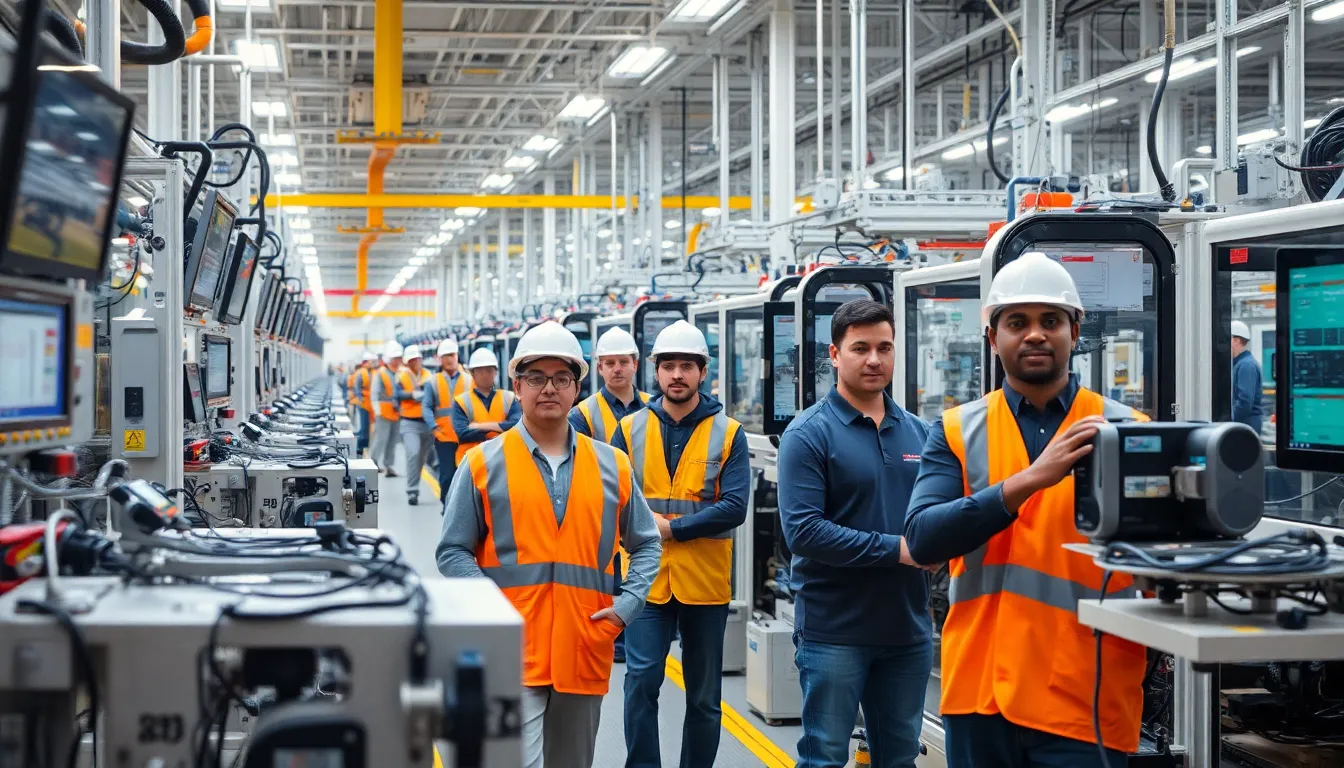In a world where toasters can tweet and fridges can order groceries, the Internet of Things (IoT) is revolutionizing manufacturing like never before. Imagine a factory where machines chat with each other, predicting problems before they happen, and optimizing production without breaking a sweat. It’s not just a sci-fi dream; it’s the new industrial reality.
Table of Contents
ToggleOverview of Internet of Things Manufacturing
Internet of Things (IoT) manufacturing leverages interconnected devices to optimize production processes. Sensors, machines, and systems communicate in real-time, allowing for immediate data analysis and decision-making. This connectivity drives efficiencies in resource management and reduces operational costs.
Data generated from IoT devices enhances predictive maintenance strategies. By analyzing performance metrics, manufacturers can identify equipment that needs servicing before failure occurs. Companies prevent downtime, saving time and money in the process.
Automation plays a critical role in IoT manufacturing. Robots equipped with IoT technology can perform tasks with precision, adapting to changes in production demands. For example, assembly lines can adjust output without human intervention, responding instantly to varying product specifications.
Integration of IoT systems also enhances supply chain visibility. Manufacturers track inventory levels, shipments, and order statuses in real-time. This transparency improves collaboration between suppliers and manufacturers, fostering more responsive logistics.
Security remains a priority in IoT manufacturing environments. Cybersecurity measures protect sensitive data and ensure device integrity. Manufacturers implement multi-layered security protocols to mitigate risks associated with connected devices.
Overall, IoT manufacturing transforms traditional practices, driving innovation across industries. Increased productivity and enhanced flexibility characterize this modern manufacturing landscape. As technology evolves, continuous advancements in IoT will further shape the future of manufacturing.
Key Technologies in IoT Manufacturing

IoT manufacturing relies on several key technologies that enhance efficiency and connectivity in production environments.
Sensors and Actuators
Sensors gather real-time data from machines, processes, and environments. These devices monitor variables like temperature, pressure, and vibration. Actuators, on the other hand, implement changes based on sensor data. They control physical components such as valves, motors, and switches. By using this technology, manufacturers achieve greater accuracy in operations and swift responses to changing conditions. Enhanced monitoring capabilities lead to improved decision-making and minimize error rates during production.
Connectivity Solutions
Connectivity solutions form the backbone of IoT manufacturing systems. Various communication protocols such as Wi-Fi, Bluetooth, and LPWAN facilitate device interconnectivity. Reliable network infrastructure ensures that data flows seamlessly between machines, sensors, and cloud platforms. Real-time data exchange enhances collaboration across manufacturing processes. Additionally, edge computing optimizes data processing close to the source, reducing latency and improving responsiveness. These connectivity solutions enable manufacturers to act swiftly, fostering innovation and maintaining competitive advantage.
Benefits of Implementing IoT in Manufacturing
Implementing IoT in manufacturing yields multiple advantages, enhancing both operational efficiency and quality standards. Organizations adopting IoT technologies experience significant transformations.
Enhanced Efficiency
Manufacturers observe a substantial increase in production efficiency through IoT integration. Connected devices collect and analyze data in real-time, allowing immediate decision-making. This proactive approach minimizes machine idle times. Resource allocation becomes more effective, leading to reduced energy consumption and waste. Furthermore, automation driven by IoT ensures tasks are completed with higher precision. Employees spend less time on repetitive tasks, allowing them to focus on strategic initiatives. Optimizing these processes ultimately boosts overall productivity.
Improved Quality Control
Quality control benefits significantly from the data insights generated by IoT systems. Sensors monitor production lines continuously, gathering critical performance metrics. This constant oversight identifies quality issues before products reach consumers. Quick adjustments to processes maintain product standards and consistency. Advanced analytics provide manufacturers with actionable insights, enhancing decision-making regarding quality improvements. By addressing defects early, manufacturers not only improve customer satisfaction but also reduce costs associated with recalls and reworks. Quality becomes a competitive advantage in the evolving manufacturing landscape.
Challenges in IoT Manufacturing
IoT manufacturing faces significant challenges, particularly in data security and system integration. Addressing these issues is crucial for maintaining operational integrity and efficiency.
Data Security Concerns
Data security remains a primary challenge in IoT manufacturing environments. Manufacturers collect sensitive information from interconnected devices. Cyberattacks pose risks that can compromise this data, impacting operations and customer trust. Multi-layered cybersecurity measures are essential to protect data and device integrity. Regular updates and monitoring of security protocols help safeguard against vulnerabilities. Manufacturers must prioritize training employees on security awareness to minimize human error, a common vulnerability in operational systems.
Integration with Existing Systems
Integration with existing systems presents a notable challenge for many manufacturers. Many businesses still rely on legacy systems that may not communicate effectively with newer IoT technologies. Seamless integration enables data flow and enhances operational efficiency but often requires substantial investments. Manufacturers might face compatibility issues during the transition process. Utilizing middleware solutions can bridge gaps between systems, facilitating smoother integration. Adjusting existing workflows to incorporate IoT capabilities often results in temporary disruptions but yields long-term benefits in efficiency and productivity.
Future Trends in Internet of Things Manufacturing
Real-time data analytics will play a pivotal role in IoT manufacturing’s future. Increased processing power enables faster data analysis, allowing manufacturers to make quicker decisions. Enhanced artificial intelligence systems will interpret data more accurately, improving predictive maintenance outcomes.
Expanded use of edge computing is expected in coming years. Decentralizing data processing reduces latency, leading to optimized operations. Sensors will continuously monitor machinery health, providing instant feedback to operators about potential issues.
Sustainability will gain more prominence within IoT manufacturing. Increasing focus on reducing energy consumption and waste will drive innovations in resource management. Circular economy models will emerge, enabling manufacturers to recycle materials more effectively.
Collaboration among devices will accelerate. Enhanced interoperability between IoT devices and systems will foster greater efficiency in manufacturing processes. Connected equipment will share data seamlessly, improving overall productivity.
Security protocols will evolve to combat rising cyber threats. Manufacturers will implement advanced encryption techniques alongside AI-driven security measures. Robust cybersecurity strategies will become integral to maintaining trust and operational integrity.
Customization will define the future landscape of IoT manufacturing. Manufacturers will leverage IoT data to create personalized products, catering to specific customer preferences and trends. Adaptive production lines will adjust processes swiftly based on real-time demand signals.
Investment in workforce training will remain crucial. As technology advances, skilled operators will be essential to manage IoT systems effectively. Addressing the skills gap will enable smoother transitions to new manufacturing modalities.
Understanding these trends prepares manufacturers for a competitive edge. Staying ahead of technological advancements will position them for success in an increasingly interconnected production environment.
The Internet of Things is redefining the manufacturing landscape. Its ability to connect devices and streamline processes leads to remarkable efficiency and productivity gains. As manufacturers embrace this technology, they unlock new opportunities for innovation and growth.
While challenges like data security and system integration remain, the benefits far outweigh the obstacles. By prioritizing cybersecurity and investing in workforce training, manufacturers can navigate these issues effectively.
Looking ahead, the integration of advanced analytics and artificial intelligence will further enhance decision-making and operational efficiency. As IoT continues to evolve, it will shape a more responsive and sustainable manufacturing environment, ensuring businesses remain competitive in an ever-changing market.



